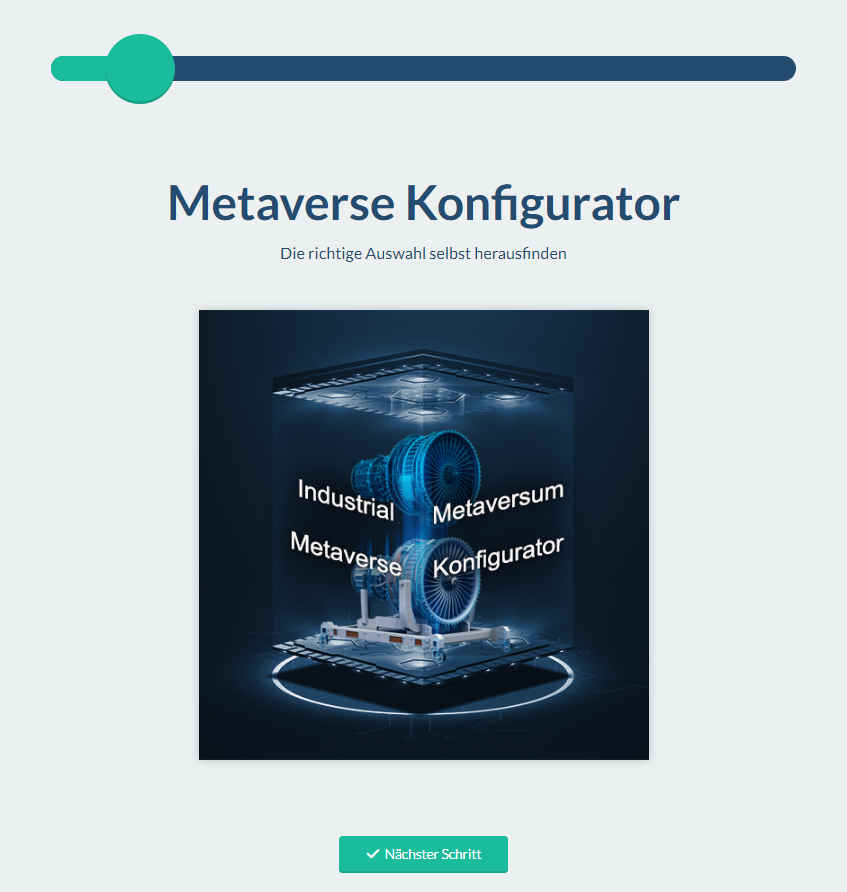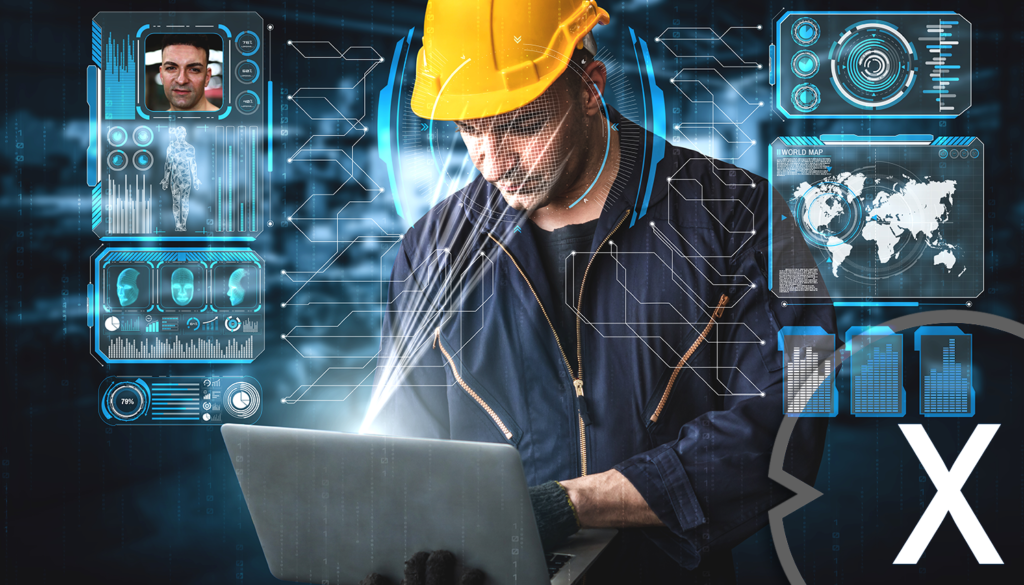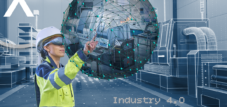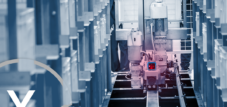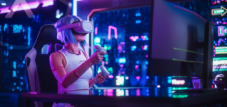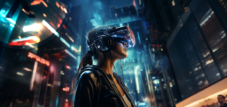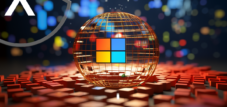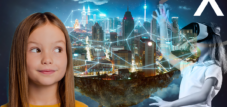Metaverse 360° - The biggest mistake in thinking about Metaverse - It's more than 3D & Communication & Chatroom | Smart sensors
Language selection 📢
Published on: July 6, 2023 / update from: July 6, 2023 - Author: Konrad Wolfenstein
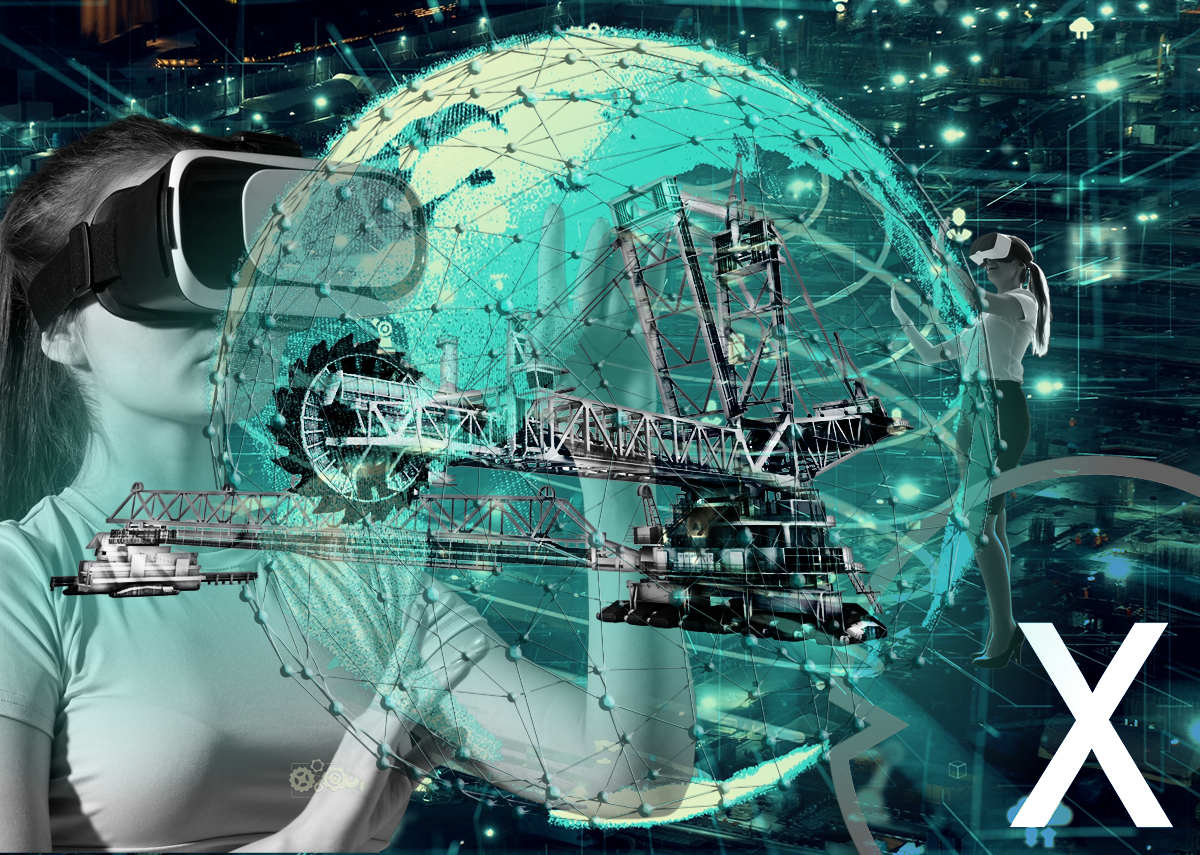
Metaverse 360° - The biggest mistake in thinking about Metaverse - It's more than 3D & Communication & Chatroom - Image: Xpert.Digital
For those in a hurry, here is the short version: The fusion of the physical and digital worlds: The potential of the Metaverse and XR technologies
Until a few years ago, the Internet and the physical world were still separated. With sensor technology, the “Internet” learned to run in the physical world. Industrial sensors played an important role in the development of the Internet of Things (IoT) and drove the digitization of industrial environments.
Digitalization aims to connect the physical and digital worlds and create interfaces between them. Physical objects, processes and systems are converted into digital formats in order to better understand, control and optimize them.
XR technologies (Extended, Augmended, Mixed and Virtual Reality) go one step further and enable augmented reality in 3D, in which the perception of reality can be optimized through additional information. This opens up new possibilities for various applications and industries.
Global logistics e.g. B. is preparing to move to 2D matrix code in 2027 (Sunrise 2027) to provide even more data for intelligent solutions and improvements. Among other things, 3D interaction options with XR and the Metaverse.
The Metaverse is seen as the next step to further advance the potentiation of digitalization. The use of 3D technology enables rapid, real-time availability and improves the efficiency of logical processes. It enables cross-border, real-time interaction from anywhere in the world. When the physical world is inaccessible due to distance or absence, the digital twin in the metaverse can serve as a temporary replacement.
Currently, the Metaverse is often reduced to virtual communication and encounters, similar to an improved chat room in 3D. However, this does not represent progress in terms of digitalization, but rather a step backwards due to the (still) limited imagination for the comprehensive possible uses.
The following points are addressed in the following text:
- From Industry 4.0 to Metaverse: The Evolution of Digitalization
- Sunrise 2027: Logistics in the age of 2D matrix code and global networking
- The next level of digitalization: The Metaverse and its diverse application possibilities
- From Sensors to the Metaverse: How Technology Breaks Down the Boundaries Between Worlds
Our Industrial Metaverse configurator
Just try out our universally applicable (B2B/Business/Industrial) Metaverse configurator for all CAD / 3D demo options:
Xpert (B2B/Business/Industrial) Metaverse configurator for all CAD / 3D data can be used on all devices, one platform!
Suitable for:
The power of data: How industrial sensors and XR technologies are driving digitalization
Until a few years ago, the Internet and the physical world were largely separated. The Internet was a global “visual” space in which information was replaced and digital content was provided. The physical world, on the other hand, was the real space in which we live, work and interact. With the development of sensor technology, however, the “Internet” began to act and interact in the physical world.
Industrial sensors played a crucial role in the advancing development of the Internet of Things (IoT). These sensors are used in industrial environments to collect data from the physical environment, such as temperature, pressure, humidity or movement. The collected data is then transmitted wirelessly and can be used to monitor machines, optimize production processes, track inventory and ensure quality.
However, digitalization goes far beyond the mere networking of sensors. It involves converting physical objects, processes and systems into digital formats to better understand, control and optimize them. Digitalization creates, analyzes and uses data on a large scale to make informed decisions and enable more efficient processes.
XR (augmented reality) technologies go one step further, enabling an immersive 3D experience in which the perception of reality is optimized with complementary information. These technologies open up new possibilities in areas such as design, simulation, training and virtual collaboration.
Global logistics is also preparing to move to 2D matrix code in 2027 to provide even more data for intelligent solutions and improvements. The combination of 2D matrix code data and 3D technologies enables even faster availability of information in real time, which further increases the efficiency and accuracy of logical and, in this example, logistical processes.
The Metaverse is often viewed as the next step in this evolution. It enables seamless, cross-border and always available interaction with digital content and people. The Metaverse opens up new possibilities for virtual collaboration, education, commerce, entertainment and much more. It allows people to interact with others anywhere, at any time, and experience digital content in an immersive environment.
Currently, however, the Metaverse is often perceived as just a kind of extended chat room in 3D, which is currently due to a limited imagination of the possibilities. The Metaverse has the potential to go far beyond this and create a comprehensive connection between the digital and physical worlds. It can be a platform where people, companies and machines work together, exchange ideas and develop innovative solutions.
Digitalization is about connecting the digital world with the physical world and creating interfaces between them. Industrial sensors have undoubtedly contributed greatly to the advancement of IoT by enabling the collection and transmission of data from the physical environment. However, digitalization itself encompasses a broader range of technologies and concepts, including XR technologies, 3D visualization, global logistics optimization and the metaverse.
From separation to merger, from virtual chat rooms to comprehensive digital transformation in the metaverse
The vision of a largely paperless world is actually not part of digitalization, but rather a positive side effect of it. The real core is converting physical objects, processes and systems into digital formats to better understand, control and optimize them. Huge amounts of data are generated and analyzed to gain insights and create more efficient workflows.
XR technologies such as augmented reality (AR) and virtual reality (VR) expand our perception of reality and offer additional information and interaction options. They find application in various areas such as design, training, simulation and virtual collaboration. By integrating XR technologies into digitalization, complex tasks can be managed more effectively and better decisions can be made.
The global logistics industry is preparing to use 2D matrix codes in 2027 (Sunrise 2027) to provide even more data for intelligent solutions. This enables improved tracking, monitoring and increased efficiency of logistical processes. In addition, the use of 3D technologies enables faster availability of real-time information, which further optimizes logistics.
The concept of the Metaverse goes beyond previous virtual worlds and offers a comprehensive connection between the digital and physical worlds. It opens up the opportunity to move freely in an immersive environment, interact with others and experience digital content. The Metaverse can serve as a platform where people, companies and machines collaborate, exchange ideas and develop innovative solutions.
Currently, the Metaverse is often reduced to a virtual communication and meeting place in 3D, but this does not fully exploit its actual potential. It offers the chance to overcome physical limitations and create temporary digital twins to operate in a virtual environment when the physical world is remote or unavailable.
The role of industrial sensors in the development of the Internet of Things (IoT)
Industrial sensors have certainly played a significant role in the development of the Internet of Things (IoT), but it would be incorrect to say that they made IoT possible. IoT is the concept of connecting physical devices and objects over the Internet to collect, exchange and use data. It encompasses a variety of technologies, including wireless communications, computing and cloud services.
However, industrial sensors play a crucial role in the IoT ecosystem. These sensors collect data from the physical environment, such as temperature, pressure, humidity, motion or other metrics, and transmit it wirelessly to other devices or systems. This data can then be analyzed and used to optimize processes, make decisions or offer new services.
Industrial sensors have helped advance IoT in industrial environments by enabling a variety of applications such as machine and equipment monitoring, production process monitoring, inventory tracking, quality assurance, and more. They are an essential part of networked devices, machines and systems in industry.
However, it is important to note that IoT is also used in other areas such as smart homes, healthcare, transportation systems, agriculture, logistics and many other application areas. Different types of sensors and technologies play a role in these areas, not just industrial sensors.
Overall, industrial sensors have certainly contributed to the development and spread of IoT by enabling the collection and transmission of data from the physical environment. However, they are not the sole foundation of the IoT, but rather an important part of a broader technological ecosystem.
The basic idea of digitalization
The basic idea of digitalization is to connect the digital world with the physical world and create interfaces between them. Digitalization transforms physical objects, processes and systems into digital formats to better understand, control and optimize them.
The connection of the digital and physical world makes it possible to collect information from the real world, process it digitally and, based on it, carry out actions in the physical world. Sensors, data transmission technologies, data analysis, software platforms and other technologies are used for this purpose.
The creation of interfaces is a central aspect of digitalization. The aim is to enable communication and the exchange of information between digital systems and physical objects, such as machines, devices or sensors. These interfaces serve as a bridge between the digital and physical worlds to collect, transmit, process and take actions on data.
Providing interfaces also includes the development of standards, protocols and technologies to ensure interoperability and smooth data exchange between different systems and devices. Examples of interfaces in the context of digitalization are APIs (Application Programming Interfaces), protocols such as MQTT (Message Queuing Telemetry Transport) or OPC UA (OPC Unified Architecture) and other technologies that enable data exchange and integration of systems.
By connecting the digital world with the physical world and providing interfaces, digitalization opens up new opportunities to increase efficiency, automate, monitor, analyze and optimize processes in various areas such as industry, healthcare, transport, energy and many others.
The future of business: The metaverse is conquering industry, business and e-commerce
The concept of the metaverse has become increasingly important in recent years and is seen as a possible next step in virtual development. It encompasses a non-physical reality that allows people to explore, interact, and transact digital worlds. Three areas have developed within the metaverse that are particularly important for the economy: the industrial metaverse, the business metaverse and the e-commerce metaverse. Each of these areas has its own characteristics and differences.
1. Industrial Metaverse
The Industrial Metaverse refers to the use of metaverse technologies in industrial applications and processes. Companies can use the metaverse to simulate and optimize virtual factories, production facilities or systems. It enables teams in different locations to collaborate virtually, inspect and maintain assets remotely, and train employees in safe and realistic virtual environments. The Industrial Metaverse thus offers increased efficiencies, cost savings and improved ways of working for companies in various industries such as manufacturing, construction or energy generation.
2. Business Metaverse
The Business Metaverse focuses on using the Metaverse for business purposes. This is about creating virtual offices, conference rooms and work environments where employees can collaborate remotely. The Business Metaverse enables companies to hold meetings and events in an immersive environment where participants can use their digital avatars. It also offers the opportunity to present products and services virtually and enable customer interactions in a realistic environment. The Business Metaverse is revolutionizing the way companies work by breaking the boundaries of the traditional office setting and creating new opportunities for global collaboration.
3. E-Commerce Metaverse
The e-commerce metaverse refers to the use of the metaverse in the area of electronic commerce. Virtual marketplaces and stores are created here where consumers can buy products and services. The e-commerce metaverse enables an immersive and interactive shopping experience where customers can use their digital avatars to explore virtual stores and view products from different perspectives. It also offers the ability to present personalized recommendations and tailored offers based on individual user behavior. The e-commerce metaverse opens up new sales channels for companies and creates a unique shopping experience for consumers.
➡️ These three areas of the Metaverse - the Industrial Metaverse, the Business Metaverse and the E-Commerce Metaverse - are all important developments that make non-physical reality a serious development for business. Each area offers unique opportunities and benefits for companies in different industries. While the Industrial Metaverse enables efficiencies and cost savings in production, the Business Metaverse enables global collaboration and the E-Commerce Metaverse creates an interactive and personalized shopping experience for consumers. As the metaverse continues to evolve, these areas are expected to continue to grow, creating new opportunities for companies to thrive in the virtual world.
As an interface to physical trade fairs and events, a metaverse offers several advantages (including as a hybrid trade fair) and brings added value in various ways
Global reach
A metaverse allows people from all over the world to take part in trade fairs and events without having to be physically present. This opens up a larger audience and allows companies to showcase their products and services to a global audience.
Cost and time savings
Participation in physical trade fairs and events often requires significant investments in travel, accommodation and stand rentals. By using a metaverse, these costs can be reduced because participants can take part in the events virtually. This saves time and money and allows participants to focus on interacting and sharing without having to worry about logistical challenges.
Interactive and immersive experiences
A metaverse can provide a highly immersive and interactive environment where participants can access virtual booths, try out products, view presentations, interact with other participants, and even conduct virtual businesses. This creates a realistic experience that comes close to physically visiting a trade fair or event.
Flexibility and scalability
A metaverse enables organizers to design trade fairs and events in a flexible and scalable manner. There are no space limitations, meaning more exhibitors and participants can participate than at a physical event. In addition, events can take place over a longer period of time as the virtual environment is accessible around the clock.
Data and analysis options
The digital nature of a metaverse allows extensive data about participant behavior to be collected and analyzed. Organizers and exhibitors can gain insights into visitor behavior, interests and preferences to improve their offerings and marketing strategies.
sustainability
By reducing travel and using virtual resources, using a metaverse contributes to sustainability. There are fewer CO2 emissions and environmental impacts, which is overall more environmentally friendly than physical events.
➡️ These advantages make a metaverse useful as an interface to physical trade fairs and events and provide added value for organizers, exhibitors and participants by expanding reach, reducing costs, enabling immersive experiences, providing flexibility and using data to make better decisions.
The Metaverse: Where the digital and physical worlds merge - The synergistic fusion of reality and virtuality
The Metaverse has the potential to usher in a new era of interaction between the digital and physical worlds. It goes beyond mere entertainment and offers a wide range of applications where digital and real elements interact synergistically. Below are 10 exciting application examples that illustrate the enormous potential of the metaverse:
1. Education and training
The Metaverse can serve as an interactive learning environment where students can visit virtual classrooms, visualize complex concepts, and gain hands-on experience in immersive simulations.
2. Telepresence and remote work
The Metaverse allows people from different parts of the world to collaborate virtually, hold meetings, and present themselves in a shared environment to increase a sense of presence and collaboration.
3. Architecture and Design
Architects and designers can use the Metaverse to create virtual models of buildings and spaces, present to clients and make adjustments in real time. This allows for an immersive and realistic vision of the final project.
4. Tourism and travel
The Metaverse allows people to virtually explore destinations, visit historic sites and have cultural experiences without being physically present. This opens up new opportunities for the tourism sector and enables barrier-free travel.
5. Healthcare and Medicine
The Metaverse can be used for medical training, virtual surgeries and the treatment of phobias and anxiety disorders. It also offers the possibility for telemedicine consultations and monitoring of patients remotely.
6. Art and Creativity
Artists and creatives can use the Metaverse to create virtual works of art, hold exhibitions and create interactive experiences. It opens new avenues for collaboration and access to artworks worldwide.
7. Trade and e-commerce
Companies can use the Metaverse to open virtual stores where customers can explore and purchase products in an immersive environment. It enables personalized shopping experiences and a close connection between customers and brands.
8. Entertainment and Gaming
The Metaverse offers endless possibilities for interactive games, virtual concerts, movie screenings and other forms of entertainment. It creates a deep and social experience for the players and spectators.
9. Sports and fitness
The Metaverse allows people to engage in sporting activities, participate in competitions and interact with other participants in virtual environments. It also offers the opportunity to offer personalized fitness programs and increase motivation for an active life.
10. Social interaction and community
The Metaverse enables people to meet in virtual worlds, find new friends, take part in events and exchange ideas with like-minded people. It creates a global community and promotes collaboration and cultural exchange.
➡️ These 10 application examples show just a small insight into the diverse possibilities of the metaverse. As this technology continues to be developed and established, new and exciting areas of application will emerge that will have a lasting impact on our daily lives in the digital and physical world.
Smart Sensors: From antiquity to today: The development of sensor technology and the basic idea behind it
The development of sensor technology has a fascinating history that is closely linked to the progress of humanity and its needs. The basic idea behind sensor technology is to capture and measure information about the environment to facilitate human activities, gain scientific knowledge and monitor complex systems.
The beginnings of sensor technology go back a long way. Even in ancient times, simple sensors were used to measure, for example, temperature, air pressure or humidity. However, it was only over the centuries and with advances in technology that ever more powerful and specialized sensors could be developed.
An important milestone in sensor technology was the invention of the mercury thermometer in the 17th century by the German physicist Gabriel Fahrenheit. This instrument made it possible for the first time to accurately measure temperatures. As a result, various types of sensors have been developed to detect electrical, magnetic, chemical and other physical quantities.
With the advent of electronics and microchip technology in the mid-20th century, sensors became smaller, more energy efficient, and less expensive. This paved the way for numerous applications of sensor technology in various areas.
A significant advance was the development of the Hall effect sensor in the 1960s. This sensor is based on the Hall effect, in which an electrical voltage is generated perpendicular to a current flow in a magnetic field. The Hall effect sensor made it possible to measure magnetic fields precisely and was used in numerous applications, including in the automotive industry for speedometers and ABS systems.
Sensor technology has made enormous progress in the last few decades. Today there is a wide range of sensors that are used in almost all areas of daily life. In medical technology, for example, biosensors enable the monitoring of vital parameters such as heart rate, blood pressure and blood sugar levels. In environmental monitoring, sensors are used to measure air and water quality and monitor pollution. In industry, sensors are used to control production processes and monitor machines to prevent failures and accidents.
Smart sensors
An interesting aspect of sensor technology is the development of intelligent sensors. These sensors are equipped with microprocessors and communication technology to process and transmit data wirelessly. This means they can be used in networked systems to handle complex tasks. An example of this are the sensors in smartphones, which not only record position, movement and ambient brightness, but also
Thanks to the integration of GPS, gyroscope and other sensors, enable a variety of functions such as navigation, health monitoring and augmented reality applications.
Another interesting trend in sensor technology is the development of miniaturized and wearable sensors. These sensors are small enough to be worn on clothing or the body and allow continuous monitoring of various parameters. For example, wearable fitness trackers can monitor the user's heart rate, activity and sleep, providing valuable data for personal health care.
An emerging area in sensor technology is the development of environmental sensors for the Internet of Things (IoT). These sensors are designed to capture and wirelessly transmit environmental information such as temperature, humidity, noise levels and air quality. This allows cities, businesses and private households to monitor environmental parameters in real time and take action to improve environmental quality and promote energy efficiency.
The development of sensor technology is also driven by other technologies such as artificial intelligence and machine learning. By combining sensors with intelligent algorithms, patterns and relationships in the recorded data can be recognized. This enables advanced applications such as facial recognition, autonomous driving and robotics.
It is important to emphasize that sensor technology plays a role not only in the technology industry, but also in many other areas such as medicine, environmental research, space travel and security. Sensors enable scientists to collect data, test hypotheses and gain new insights.
The future of sensor technology promises exciting developments. Sensors are expected to become smaller, more efficient and more cost-effective. New materials and manufacturing techniques enable the creation of flexible sensors that can be bent, stretched and even integrated into textiles. This opens up new possibilities for health monitoring, rehabilitation, virtual reality and human-machine interaction.
The development of sensor technology is an exciting process driven by the desire for better information gathering and monitoring. From simple temperature measurements to highly complex interconnected sensor networks, sensor technology has an enormous impact on our daily lives and will continue to play a significant role in the future.
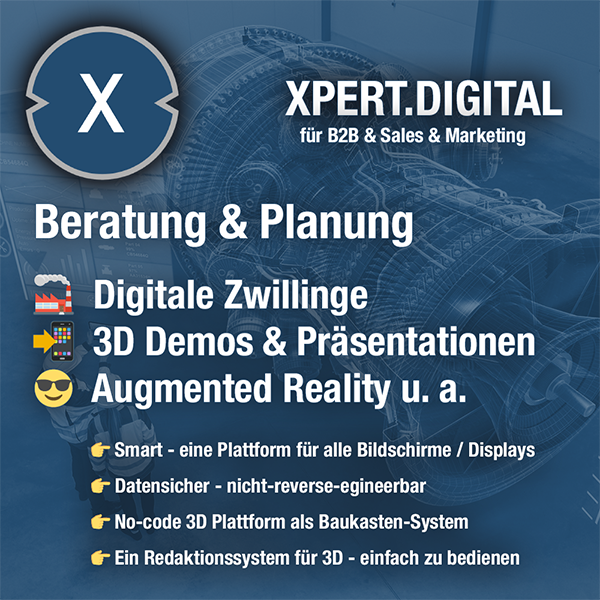
Xpert.Digital – Pioneer Business Development
I would be happy to serve as your personal advisor.
You can contact me by filling out the contact form below or simply call me on +49 89 89 674 804 (Munich) .
I'm looking forward to our joint project.
Xpert.Digital – Konrad Wolfenstein
Xpert.Digital is a hub for industry with a focus on digitalization, mechanical engineering, logistics/intralogistics and photovoltaics.
With our 360° business development solution, we support well-known companies from new business to after sales.
Market intelligence, smarketing, marketing automation, content development, PR, mail campaigns, personalized social media and lead nurturing are part of our digital tools.
You can find out more at: www.xpert.digital – www.xpert.solar – www.xpert.plus



